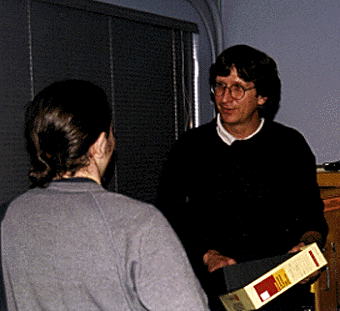![[Currents header graphic]](/homeart/currents_header.gif)
![[Currents header graphic]](/homeart/currents_header.gif)
February 9, 1998

|
|
Rick Carter shared his experiences with students in film and video
|
As an art major at UCSC in the early 1970s, Rick Carter says he never did well with landscapes. Ironically, over the past 25 years, Carter has enjoyed an enormously successful career creating backgrounds--three-dimensional backgrounds that are viewed by millions each year.
Carter, who graduated in 1974, is one of Los Angeles's top production designers, responsible for the sets in such films as Amistad, Jurassic Park, Jurassic Park: Lost World, Forrest Gump, Back to the Future, and Death Becomes Her. He visited the campus in late January to speak about his job to a film and video class taught by theater arts professor Chip Lord.
Carter opened his talk by noting that almost no one knows what a production designer does. "Production designers create everything that audiences don't think about when they watch a movie. Our job is to create the spirit of the place," he explains. For Carter this has meant everything from building slave ships (Amistad) to stately southern mansions (Forrest Gump) to dinosaur pens (Jurassic Park and Jurassic Park: Lost World.
A large part of Carter's job is creating a world where none may exist. Most of his sets spring up out of nowhere and return to the same place when filming is done. Carter oversaw construction of the Gump home, of which he seems especially fond. "It's too bad we had to tear it down; with electricity and water, that house would have made a wonderful bed and breakfast," he says wistfully. A working farm was also needed for the film and so, just down the road from the Gump home, an entire farm was planted. And, while they were at it, they created Vietnam in the same neighborhood, using the area to shoot some of the film's war sequences.
"In production design, there are times when you have to take something that feels like a disaster and turn it into a success," Carter told the class. "You're shifting gears very quickly and you have to think on your feet. You have to get to a point where you enjoy the fact that your brain is being fried."
Some of Carter's most colorful stories come from the times when he has worked with Steven Spielberg. For example, the sets for Jurassic Park had been built and filming was under way before the final portions of the script had been written.
"People say Spielberg's visualizing ability is as good as it gets," Carter notes. And when Spielberg watched the imposing T-rex appear at the beginning of the film, he realized he had to have it reappear at the end. This was a tricky proposition, Carter said, since the final sequences take place in the visitor center which had no entryway big enough to accommodate the gargantuan T-rex. Carter rigged an ambiguous looking backdrop through which the T-rex made its way. In the end, the scene was a success and, anyway, who's going to notice with all those enormous teeth looming on the screen.
Carter oversees budgets that have gone as high as $6 million (Jurassic Park: Lost World being his most expensive budget). But his beginnings were more humble. His first experience in production design was on the set of Bound for Glory, which he followed with work in television production. He didn't stay in that arena long, the last straw being his stint doing special effects for The Six Million Dollar Man. "It was like working on a GM production assembly line," Carter said, adding that "the main special effect was Lee Majors's eyebrow."
Carter is now busy at work on a new film by Robert Zemeckis (director of such films as Back to the Future, Who Framed Roger Rabbit, and Forrest Gump). The story centers on a scenario in which trout control the world. Yes, really. "The creative process, how it works, is scary," Carter says. This latest project may prove to be the best example yet of that notion.